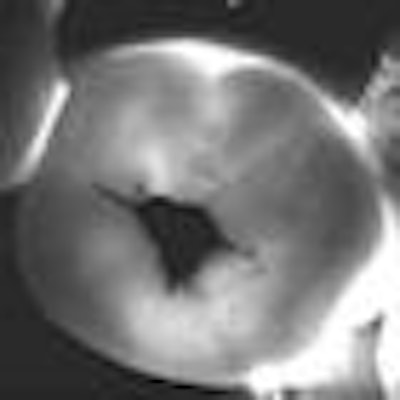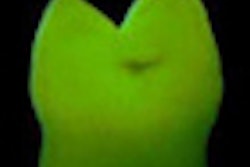
Numerous studies have shown the ability of caries detection tools to enhance the detection of occlusal lesions. New research suggests they can also trigger more aggressive treatment choices.
Reporting in the European Journal of Oral Sciences (February 2009, Vol. 117:1, pp. 51-57), a group of international researchers set out to evaluate whether having results from multiple detection methods influences dental treatment decisions for incipient caries lesions on occlusal surfaces. Led by Dr. Antonio Carlos Pereira of the Piracicaba School of Dentistry in São Paulo, Brazil, the team compared visual assessment of 96 extracted permanent molars to data obtained using four additional caries detection methods -- bitewing radiographs, electric conductance measurement (ECM), quantitative light fluorescence (QLF), and laser fluorescence (LF, specifically Diagnodent by KaVo Dental) -- on the same teeth.
Three examiners were used -- all university teachers with up to four years of experience in clinical practice. Prior to participating in the study, they underwent six hours of training: two hours of theoretical training and four hours of practice on extracted teeth.
They first examined the teeth using ECM, then performed a visual exam (without an explorer) and made a treatment decision during the same session. One week later, they performed the radiographic, LF, and QLF examinations. Three weeks after that, they were asked to re-evaluate the teeth and their original treatment recommendations using the additional data obtained with the caries detection devices.
While only slight improvement in the percentage of correct diagnoses was seen when the additional detection methods were used, "a drastic effect" on treatment choice was observed, the researchers stated. In particular, by having results available from multiple detection methods, the choice of invasive treatment -- versus no treatment or preventive/noninvasive treatment such as applying a sealant -- increased "substantially," they noted.
Overtreatment existed at two levels, they added: applying noninvasive treatment to sound teeth and applying invasive treatment to teeth with enamel lesions.
"The former is 'harmless' although costly, and the second is disastrous," the researchers wrote.
In the long run, they concluded, having data from multiple methods did not improve the accuracy of the examiners in detecting early occlusal caries lesions, but it had a "great influence" on the number of surfaces indicated for operative treatment.
The study has other implications as well, according to Dr. Pereira.
"In my opinion, this study shows that each diagnostic method has different characteristics," Dr. Pereira stated in an e-mail interview with DrBicuspid.com. "Diagnodent has a high sensitivity for initial caries, but also a high level of false positives. ECM is great for dentin caries but fails at the enamel level. Professionals are [encouraged] to understand the new knowledge of caries diagnostic methods and use them, keeping in mind that most caries are at the incipient level and thus prone to preventive treatment."
Douglas Young, D.D.S., M.S., M.B.A., an associate professor at the University of the Pacific School of Dentistry, agrees.
"This study showed that all the different technologies tested didn't necessarily increase correct diagnoses but did prompt them to treat sooner and more aggressively," he said. "It is my understanding that this study was done before the ICDAS [International Caries Detection and Assessment System] ... came out, and it would be interesting to include the ICDAS coding system in a similar study and compare results. The technologies are getting more specific, and each different technology looks for different things; for example, some look for changes in light refraction while others measure fluorescence signals coming off the teeth."
One real problem, Dr. Young added, is that aggressive marketing literature often uses the term "caries" improperly, which makes the clinician think the caries detection device is picking up "decay" earlier so they should restore earlier. "But that is not necessarily true," he said.
Rather, because the devices might be detecting demineralization rather than true decay or infected dentin, clinicians need to fully understand the particular technology they are using and realize that it is only an adjunct in decision-making. Sometimes a more conservative preventive approach could be considered first, Dr. Young suggested.
"The question then becomes, that given that the morphology of the pits and fissures make cleaning them problematic, what is the most minimally invasive way to help prevent cavitation?" he said. "The caries risk of the patient and the extent and activity of the lesion often determine if treatment is optional or elective. It is important to understand that prevention is up to the patient and that, in many cases, we should be giving them options, not dictating treatment. In many cases, all we need to do is to clean out these fissures and seal them so they don't pick up decay. But too many dentists are overly aggressive when it comes to deep restorations and aggressive prepping for sealants."
One option is to rethink the sealant procedure and place a conventional (no resin) glass ionomer as a long-term, fluoride-releasing surface protectant, Dr. Young said.
"Seal and fluoride release prevent decay, which may be more important than retention, bond strength, or even longevity for some patients," he said. "Just tell patients when the fluoride (the glass ionomer) is gone you will put some more on." This approach especially makes sense for newly erupted teeth where you do not want to prep or place a resin-based sealant that will inhibit further maturation (mineralization) of the occlusal surface, he added.
"Dr. Hien Ngo and others have shown that glass ionomers are semipermeable to some ions and have properties very similar to remineralization underneath them. To me, this is the best answer for many people, but it requires re-educating clinicians and patients alike about the treatment objective," Dr. Young concluded.
Copyright © 2009 DrBicuspid.com



















